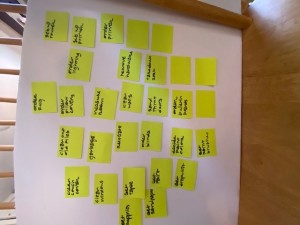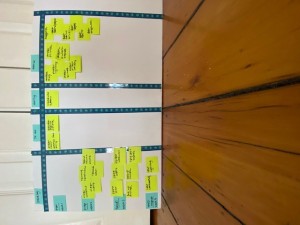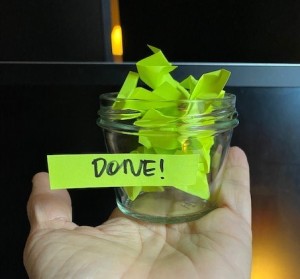It’s hard to believe that a year has passed since the world was thrown into this new normal of stay at home, do everything here, all the time.
Early on, I cycled through the first few stages of grief – denial, anger, bargaining. Global pandemic? This can’t be happening. Once spring sprung, I was depressed, sure, but then, the pragmatic me found acceptance. If I’m going to be home, here’s the silver lining: better work/life balance, fewer options, more time for home projects. I’M GOING TO “MARIE KONDO” MY LIFE! Category by category, I’m going to discard items that no longer spark joy. I’m going to create an HGTV worthy home office!
Hrmmm, where do I start? Looking around this 10×20’ multi-purpose den/storage/home office room, acceptance pretty quickly became being overwhelmed and being overwhelmed led to analysis paralysis. It was soon to be Fall, I was about to start this new job and this makeshift home office that I had grand plans to clean out and remodel still looked like an episode of Hoarders waiting to happen.
Taking an agile mindset
As a project manager, I’ve led cross-functional teams in complex transformations. To tackle multi-faceted programs and projects, I’ve taken agile, iterative approaches coupled with a scrum framework to help teams navigate and complete work. Simply put, I’ve helped teams define a big picture goal, break down work into small, manageable pieces, empower resources with what they need and GO! GO! GO!
For any size project, planning goes a long way in ensuring successful outcomes. Not to say once you create a plan, you’re locked in. Because let’s face it, no matter how perfect you think your plan is, stuff happens and plans need to flex. So, can applying what I preach professionally help me here at home to create a highly functional home office? Let’s see…
Clearly define a SMART goal
A SMART goal is specific, measurable, assignable, realistic and time-based. Articulating and consistently checking back on SMART goal(s) ensures you and your team (in this case, my husband, me and the cat?) will stay on track. As unforeseen variables and obstacles are encountered, items are adjusted within the larger framework of the SMART goal.
JESS’ SMART GOAL: Transform this room into a dedicated, technology-enabled, modern home office by September 30, 2020.
Break down the work into small, manageable chunks
In project management, we call this first activity creating a work breakdown structure. For nerds like me, it’s a fun brainstorming exercise where you and your working team, with your SMART goal in mind, note what needs to be done on individual post-it notes. (Snacks are optional and highly recommended) Think of the notes as a free form to-do list, with enough detail to understand actions needed and times to complete.
You’ve created a backlog!
The backlog is a running list of things to be done. Ideas can be posted any time and range from the very tactical near term (buy paint supplies) to the longer-term bucket list (hang new blinds).
This approach helps everyone visualize what needs to be done/planned for both in the near term and the future. And, since all tasks are front and center, no one needs to remember lists of information!
Great. A pile of post-it notes. Now what?
Once tasks are noted, move the post-its around and categorize them into manage-able buckets such as:
• Now These are priority items to be completed before anything else can be done.
• Later These are critical tasks to be completed after “Priority” items are complete
• Someday maybe These are non-critical tasks and/or future items to be planned for
For this makeover, we timeboxed the project to 4 weeks and organized tasks as follows:
• Week 1 – Plan
• Week 2 – Prep
• Week 3 – Execute
• Week 4- Test/Inspect
Commit to what you and your team can realistically do
Thinking about and committing to what can be done in 1 week is less overwhelming than committing to an entire to do list in 1 month. Pulling from the prioritized backlog to create a Kanban board helps you and your team visualize and focus on near term tasks at hand.
Here, we’ve focused our first week cycle (a sprint) on planning and timeboxed ourselves to 1 week. The team decides what can be completed, by whom and adjusts as needed. As tasks are completed, post-it notes are moved from To Do > Doing > Done.
Recalibrate plan on a regular basis and celebrate accomplishments
With regular sprint cycles, progress is achieved (and recalibrated if needed) incrementally. At the end of each cycle, the team confirms tasks are completed and celebrates (we crumple the post-its with great fanfare)
For this project, the team pulls from the prioritized backlog weekly to set up expectations for subsequent cycles. When all cycles are completed, we’ve accomplished our SMART goal and we’re ready for HGTV!






Beautiful!
Your office truly looks like something out of HGTV! This is such a helpful post, not only because I need suggestions for how to make my office more organized, but because it helps me understand Agile in everyday language.
I too use the kanban approach to organize my to do list on a white board. I find it more efficient than writing/rewriting tasks each week. I love the before/after of your office. Nicely done! 🙂